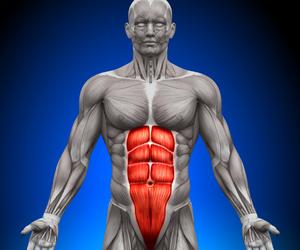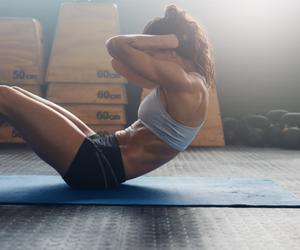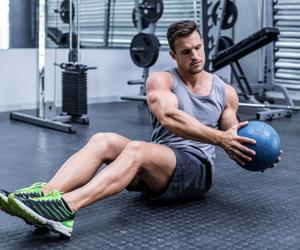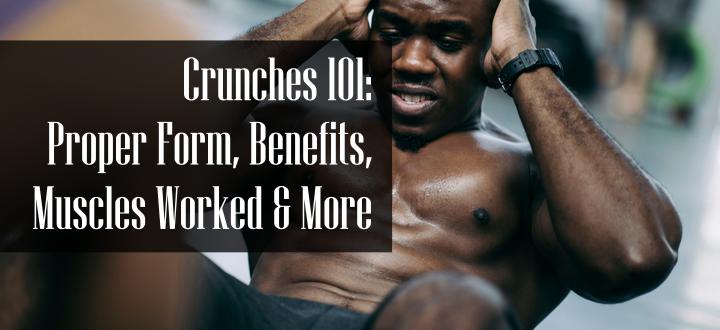Sit-ups and Crunches have been an essential part of any fitness regimen for decades, but many people still don’t know the proper form or the benefits they can get from these exercises.
This article will cover everything you need to know about crunches, including the muscles worked, proper form and technique, the benefits of crunches, and more.
Let’s get to it!
Contents
- 1 How to do Crunches Correctly
- 2 Crunches Benefits
- 3 Common Mistakes to Avoid While Doing Crunches
- 4 Crunches: The Muscles Worked
- 5 Crunches vs Sit-Ups
- 6 Hometraininghero’s Suggested Reps, Sets, and Programs
- 7 Crunch Variations
- 8 Crunches Alternatives
- 9 Frequently Asked Questions (FAQ)
- 10 Final Words
- 11 Other Helpful Resources
How to do Crunches Correctly
What You’ll Need:
- A floor and your body weight: To do crunches, you do not need any equipment at all!
Alternative Equipment:
- An exercise mat: If you would like extra comfort – an exercise mat will be a nice addition. With an exercise mat, you will provide your lower back with support and comfort.
- A sit-up bench: With a sit-up bench, you provide cushioned stability to your back, and you will also have the ability to change the angle at which you work out. For added resistance, try inclined crunches.
- An exercise ball: The exercise ball is an affordable and super-effective addition to your core-workout regimen. The ball provides an extra challenge and will also make the crunches work even more muscles as it forces your core to work overtime, keeping your body stable and in place while crunching your abs.
Step1: Lie Down
Begin by lying supine on the floor with legs bent and feet flat on the ground.
Step2: Position Your Hands
Next, ensure that hands are placed lightly behind your head or alternatively crossed above your chest.
Step3: The Crunch
Then, exhale while contracting the rectus abdominis to curl the shoulders and torso from the floor towards the pelvis. Stop the crunch while your spine is still in contact with the floor.
Step4: Return to The Starting Position
Finally, inhale while returning to starting position.
Crunches Benefits
Rock Solid Core
Crunches are an effective exercise for strengthening and toning the core muscles. By focusing on multiple layers of muscle simultaneously, crunches target various muscles throughout your abdominal and mid-section area.
Increased Flexibility
Strengthening your abdominal muscles through crunches can improve flexibility, making everyday movements easier and reducing the risk of injury. In addition, increased flexibility helps to prevent stiffness in the midsection, allowing you to bend and reach with greater ease.
Upright & Balanced
Doing crunches is an effective way to improve posture and balance. Strengthening the muscles around your core can help you stand taller while reducing back pain over time.
Improved strength in the abdominal region also helps enhance overall body balance, providing improved mobility, which can help reduce the risk of falls and other injuries.
Pain-Free Fitness
Crunches are an ideal exercise for those who experience joint pain or discomfort during traditional workouts.
This low-impact exercise strengthens and tones the core while providing a gentle, low-intensity movement that minimizes the chances of further injury or aggravation to sensitive joints.
With crunches as part of your fitness routine, you can effectively train without risking uncomfortable flare-ups.
Rock-Hard Abs

Crunches are one of the best all-around exercises for achieving toned abs.
Doing crunches engages multiple muscles in the abdominal area, helping to create a well-defined core strength that can help you look and feel good.
Get Fit Anywhere
With minimal to no equipment, you can do crunches anytime, anywhere. Especially during times when the gym may be closed or not available due to circumstances outside of our control, having the ability to exercise without leaving the comfort of your home or office is incredibly valuable.
Crunches are a great exercise for anyone looking for an easy way to stay healthy!
Customizable Intensity
Customizable intensity is an excellent benefit of doing crunches. With different variations available, you can decide how hard to push your body and customize the exercise accordingly.
Even if you’re a beginner or are experienced with fitness, you can tailor this exercise to best fit your needs and abilities. Furthermore, ramping up the intensity as your fitness level progresses ensures that crunches remain effective in reaching both short-term and long-term goals.
Jumpstart Your Weight Loss!
By including crunches in your workout routine, you can easily jumpstart the process of losing weight.
Crunches help to boost your metabolism, which speeds up the rate at which you can lose those extra pounds. And because they focus on strengthening and toning the abdominal muscles without putting too much strain on the body, they are an ideal exercise activity for anyone looking to shed a few pounds.
Common Mistakes to Avoid While Doing Crunches
Remember to Breathe!
To ensure you’re getting the most out of your abdominal workout, paying attention to how you’re breathing while doing crunches is super-important.
Instead of holding your breath as you lift into a crunch position, focus on consciously deep breathing throughout each repetition. This will help relax your abdomen and prevent excessive tension from building up in this area as you curl up toward the ceiling.
Don’t Overarch Your Lower Back
When performing crunches, you mustn’t overarch your lower back. This can cause strain on both the lower back and neck, as well as reduce the effectiveness of the exercise.
Instead of arching your back, keep it pressed flat against the ground as you lift up towards your knees. To ensure this position remains consistent throughout each repetition, aim to maintain contact with the floor by tucking your chin lightly and engaging your abs while lifting up towards your legs.
Take Your Time
One of the biggest mistakes people make when doing crunches is rushing through them.
Not taking your time and completing each rep with proper form is a surefire way of reducing its effectiveness while increasing the chances of causing injury. Proper form includes lying flat on your back with your feet placed firmly on the ground and keeping your chin up as you raise your upper body off the floor.
Making sure you don’t move too quickly will ensure that all muscles involved in doing crunches are engaged and that each rep is performed correctly for maximum benefit.
Focus on Technique and Form
When done improperly, crunches can strain your back muscles and shoulders rather than target the abdominal muscles you’re trying to strengthen.
Don’t Sit Too Far Up

Sitting too far up can cause strain on your neck and shoulders, reducing the effectiveness of the exercise and leading to potential injury.
Instead, bring your elbows together above your chest, then curl slowly up using just your abdominal muscles to lift before lowering yourself back down slowly. Doing this will help activate those important abdominal muscles without risking injury or straining other body parts.
Don’t Strain Your Neck
Straining the neck is one of the most common errors while Crunching.
Unintentionally straining the neck in this way can lead to pain
and poor posture over time. To avoid straining your neck, gently tuck your chin towards your chest while crunching.
Crunches: The Muscles Worked
Rectus Abdominis
The Rectus Abdominis, more commonly known as ‘abs,’ is one of the most important muscles when it comes to doing crunches.
Targeting this muscle can help you achieve optimal strength and stability throughout your core region. Doing exercises that strengthen the Rectus Abdominis is essential for proper posture, improved overall balance, and a stronger midsection – all of which will go a long way toward achieving healthier body mechanics!
Transverse Abdominis and Obliques
Crunches strengthen oblique muscles as well as primary abdominals for a more complete core conditioning.
Activating the transversus abdominis and external/internal obliques helps to promote muscular balance on either side of the torso, allowing for greater stability in every punch and crunch!
Additionally, toning these synergists assists with improved posture and a steadier base to better transfer power through legs during sport or activity, which can improve performance during a workout session.
Crunches vs Sit-Ups
Crunches and sit-ups both involve the engagement of the abdominal muscles, but they differ in terms of their biomechanical approach.
Specifically, crunches are flexion exercises that utilize an isolated contraction of the rectus abdominis muscle group. Conversely, sit-ups are performed in a more extended position and rely on a combination of both flexion and extension to engage the abdominal muscles.
Hometraininghero’s Suggested Reps, Sets, and Programs
For Gaining More Muscles
The efficacy of crunches to increase muscularity can be established by applying the progressive overload principle.
Through consistent and incremental increases in abdominal contraction, the muscles are subjected to greater tension levels than normal physical activity, thus stimulating hypertrophy and increased muscular growth. This overload can be applied through various modalities, including but not limited to: increasing duration, frequency, and intensity (e.g., weighted vests).
Reps should be tailored to individual goals; however, an effective program might include sets of 10-15 reps for 3-4 sets each day.
For Improving Overall Strength
To maximize gains in muscle strength, it is recommended to do 3 sets of 10-15 repetitions at least twice a week. Furthermore, to achieve optimal results, performing 1-2 sets of crunches with a heavier weight can help increase muscle hypertrophy over time.
For Boosting Muscle Endurance
To optimize the results of crunches for improving muscle endurance, it is recommended to perform 3 sets of 10-20 repetitions with a rest period of 45-60 seconds between each set.
Crunch Variations
The Plank Crunch
The Plank Crunch is an effective exercise for core conditioning and strengthening.
It involves dynamic movements to engage the abdominal and back muscles simultaneously. To begin, assume a plank position with elbows directly beneath the shoulders and feet slightly wider than hip-width apart. From this starting position, slowly roll up onto your toes while simultaneously performing a crunch movement by bringing your knees towards your chest while keeping the hips elevated. Then, return to the original plank position with control.
Bicycle Crunches
Bicycle crunches are a core strengthening exercise requiring minimal equipment and can be easily executed at home.
The primary muscles used in this exercise include the rectus abdominis, external oblique, internal oblique, and transverse abdominis. To perform bicycle crunches, begin in a supine position on the floor with your hands behind your head. Next, lift your shoulder blades off the ground and extend an opposing elbow to the opposite knee as you crunch inward.
Weighted Crunches
Weighted crunches are a variation of the regular crunch. The only difference is that instead of only using your body weight – you also add extra load provided by a dumbbell, medicine ball, weight plate, or any other weighted object. Lay the object on your chest, and hold it in place with your hands. Now, start crunching – and feel the burn!
Decline Crunches
- To start, lie flat on a decline bench with your head slightly lower than the rest of your body and feet hooked into the footrest provided on the bench.
- Cross your arms across your chest or place them behind your neck for support.
- Once you have assumed this position, contract your abdominal muscles and try to raise yourself up by curling towards the ceiling until you reach an angle of about 30 degrees from the original position.
- Hold for two seconds, and then slowly lower yourself back down without locking out at the bottom of each rep. Keep good form throughout this exercise by keeping a straight line from shoulders to knees during each repetition.
Reverse Crunches
Reverse crunches are an effective core exercise that works the lower abdominal muscles and can increase strength, endurance, and balance.
Performing reverse crunches is a great way to improve posture and back health and help prevent injuries during physical activity. The exercise targets the core muscles, specifically the rectus abdominis muscle group.
Here’s how to do a reverse crunch properly:
- Begin lying down on your back with your legs bent so that your feet are flat on the ground.
- Place your hands by your sides for stability and lift up to create a small arch in your back.
- Then bring both legs together towards the chest while maintaining control throughout the movement. Hold for a few seconds, then slowly return to starting position without allowing yourself to sink down into the floor too quickly or rocking from side to side as you move up or down.
Crunches Alternatives
Plank
The plank is a simple exercise that requires no special equipment and can be done by anyone at any level of fitness.
To perform it correctly:
- Start in a push-up position with your arms straight and feet slightly wider than shoulder-width apart.
- Make sure your body forms a straight line from head to toes, and hold this position for 10-30 seconds, depending on how strong you feel.
- As you become stronger, increase the duration of each hold, up to 60 seconds or more if desired.
Russian Twist

This core exercise is a great way to target and strengthen your abdominal muscles and other muscle groups in the lower body.
Russian twists are easy to incorporate into any workout routine, either at home or in the gym. They involve twisting from side to side while holding a weight or medicine ball with both hands, engaging both your obliques and hip flexors.
As a bonus, this exercise also helps improve balance and stability by strengthening all areas of the torso. Start with light weights and gradually increase your weight over time for the best results.
Be sure not to swing your arms too wide during each twist so that you can focus on keeping perfect form throughout the movement.
Sit-Ups
Sit-ups are one of the most well-known abdominal exercises and can be an effective replacement for crunches. Doing sit-ups correctly engages both the abs and hip flexors, which helps strengthen the core region overall.
Make sure to keep your feet flat on the ground and avoid any jerky movements throughout the exercise to maximize effectiveness.
Rollouts
For this exercise, you will need an ab-roller.
Consider alternatives like ab-wheel rollouts to get the most out of your ab workout. This challenging exercise can help you achieve a stronger, more toned midsection without relying solely on crunches.
The ab-wheel rollout is done by kneeling on the floor with an ab-wheel placed in front of you. With hands firmly gripping the wheel and knees pressed against it, slowly roll the wheel straight out until your arms are extended in front of you.
Maintain proper form and use your core muscles to hold the position for one second before slowly rolling back to the starting point.
This exercise works both your rectus abdominis (the “six-pack” muscle) and transverse abdominis (the deepest abdominal muscle).
Leg Raises
Leg raises are a great way to engage your abdominal muscles and add variety to your regular workout routine.
Leg Raises target both the upper and lower abdominals while engaging other important muscles, including hip flexors and obliques.
To perform a leg raise, do as follows:
- Start in a prone position with your legs straight out behind you.
- Then lift one or both legs off the ground until they reach 90 degrees or higher from their original position before returning them down slowly – with control.
Frequently Asked Questions (FAQ)
Q: How Many Muscles are Involved in Crunching?
Crunching involves the rectus abdominis, obliques, and transverse abdominis muscles.
The rectus abdominis is the most important muscle involved in crunching, as it is responsible for flexing the spine.
The obliques are responsible for side bending and rotation of the torso, while the transverse abdominis helps to stabilize your trunk during crunching.
Q: How Often Should you do Crunches to See Results?
Generally, it is recommended to do crunches 3-4 times per week.
Aim for 3 sets of 15-20 repetitions each time. Increase the number of reps and sets as you become stronger. Remember to rest between sets and use proper form for maximum benefit.
Q: Do Crunches Work Upper or Lower Abs?
Crunches primarily work the rectus abdominis, which is the large muscle that makes up the “six-pack” look.
This muscle covers both your upper and lower abs, so crunches will help strengthen both areas. However, for more targeted ab exercises, you can also perform leg raises to target your lower abs or bicycle crunches to target your upper abs.
Q: Can I Damage my Back by Doing Crunches?
Yes, if crunches are done incorrectly or with too much force, they can cause strain on your back muscles and lead to injury.
Make sure to keep your lower back flat against the floor and use proper form when doing crunches. Additionally, start with fewer reps and gradually increase as you become more comfortable.
Q: Can you Get a Six-Pack From Crunches?
Crunches can help you build abdominal muscles, but they won’t get you a six-pack.
To achieve a six-pack, you’ll need to combine crunches with a healthy diet and other exercises such as planks, leg raises, and cardio. This will help reduce fat around your stomach so that your abs are visible.
Q: Is it Better to do Crunches Fast or Slow?
Generally speaking, crunches should be done slowly and with control. This ensures that you engage the correct muscles and get the most out of each repetition.
Doing crunches too quickly can lead to improper form, which can put strain on your neck and back. Instead, aim for 2-3 seconds per crunch, squeezing your abs at the top of the motion.
Q: How Long Does it Take for Crunches to Show Results?
It depends on your starting fitness level and the intensity of your crunches.
Generally, you will notice results in about two weeks if you are doing regular crunches with good form and increasing intensity. However, more significant results may take up to 12 weeks of consistent training.
Q: Do Crunches Flatten the Stomach?
Crunches can help build abdominal muscle, but they won’t flatten the stomach on their own.
To achieve a flatter stomach, you’ll need to combine crunches with cardio exercises and a healthy diet. Regular exercise and proper nutrition will help reduce overall body fat and create the flat stomach you’re looking for.
Final Words
The crunch is a versatile exercise that targets the abs and gives you a great workout.
Getting the form and technique right is essential to achieve maximum benefits and work the muscles properly. The crunch can be modified to suit your fitness level, body type, and goals.
Adding crunches into your routine will build strong core muscles, improve your balance and help reduce lower back pain.
Start slow with fewer reps and increase as your strength increases.
Want to learn more about strength training? Visit the hometrainingheros strength training archive – loaded with workout tips and fitness hacks,
See you there!


